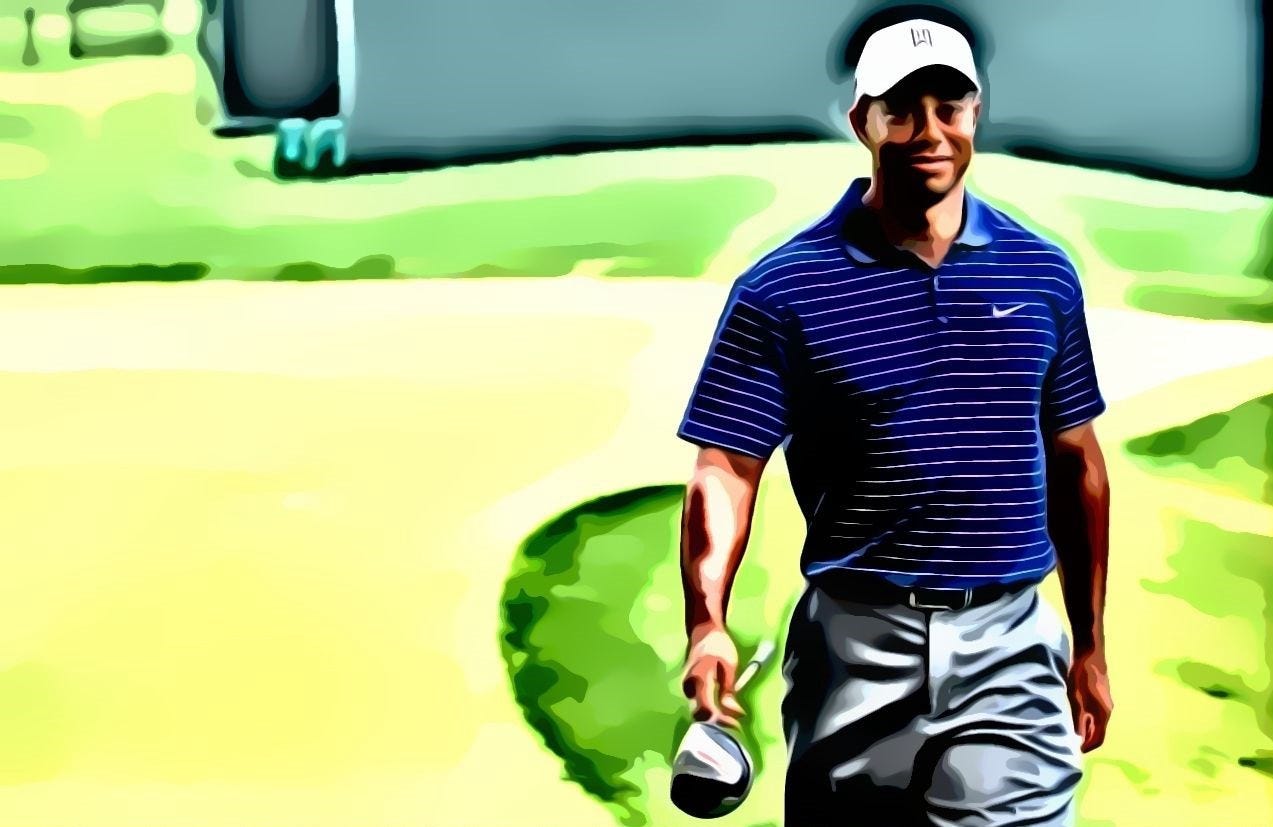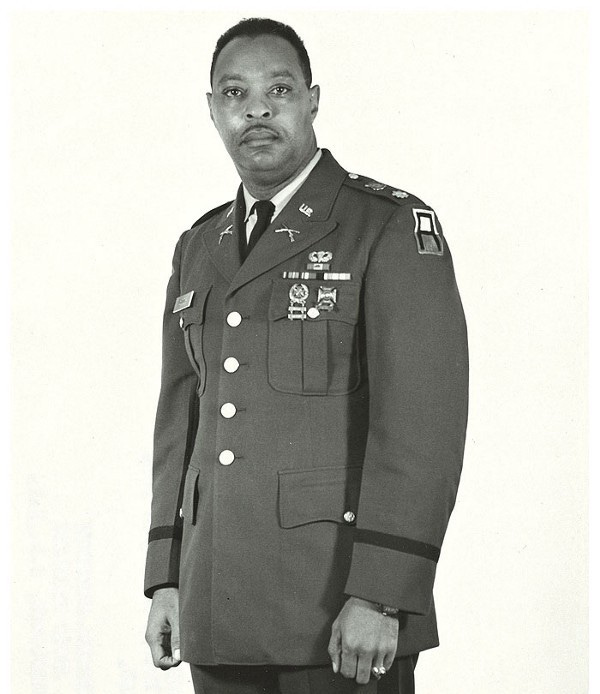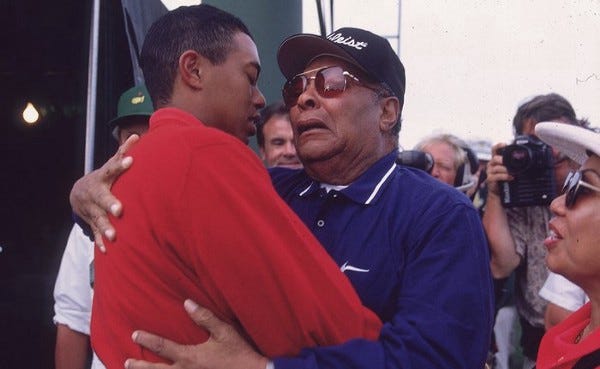The defining biography of Tiger Woods forces me, on this Father’s Day, to reevaluate the expectations I place on my own children.

On August 27, 2000, Tiger Woods was on pace to win the World Golf Championship by ten strokes. A week earlier, he had won the PGA Championship; a week before that, he won the British Open by 8 strokes, the largest margin of victory in the British Open since 1913. Woods’ lead in the WGC-NEC Invitational made his victory all but certain, but as dusk settled in over the Firestone Country Club in Akron, Ohio, he lined up for what would be one of the most difficult shots of the tournament.
Storms earlier in the day had forced a three-hour tournament delay, and Woods now geared up for what would go down in the annals of golf history as the “Shot in the Dark.” “A silhouette in the fairway, 168 yards from the 18th green,” the Associated Press would later write about the moment, “Woods cranked an unmistakably pure swing . . . The ball landed two feet from the pin.” Woods easily tapped in for birdie, securing his victory — his eighth of the year and the 23rd of his career — by eleven strokes.
Tiger’s famous “Shot in the Dark” at Firestone Country Club, Akron, Ohio, in 2000.
I’ve been thinking about this moment in Woods’ career as I’ve read Tiger Woods by Jeff Benedict and Armen Keteyian. Following the success of their bestseller The System: The Glory and Scandal of Big-Time College Football, Benedict and Keteyian have deftly assembled what is sure to be the defining biography of one of the greatest athletes who ever lived. Over three years of research the authors consumed every book, magazine article, documentary, and news clipping about Woods they could find, and added to this trove of information over four hundred interviews with people in Woods’ primary, secondary, and tertiary orbits. The result is a moving, sweeping 400-page biography that cuts through the popular narratives around Woods much like that 18th-hole shot cut through the thickening night at Firestone in August 2000.
The PGA Tour footage of Woods making that shot includes Woods’ comments in his post-tournament press conference. “I used to sneak out on the golf course to go play in the twilight like this. Dad and I used to have probably two or three holes of pitch black dark where you have to call the shot. That’s the feel and it’s how I grew up playing.” But Tiger’s casual description of evenings on the course with his father belies the nature of the Woods’ father-son relationship — it was one-dimensional, driven by a singular goal, and at times bordering on emotionally abusive. And it was all because of Earl Woods’ need to dictate the terms of his son’s existence.
Earl was born in Manhattan, Kansas in 1932. Located about 50 miles west of Topeka, Manhattan sits on a floodplain where the Kansas and Big Blue rivers meet. In the 1930 census, it had a population of just over 10,000, with Kansas State University and surrounding agriculture providing the majority of the area’s economic activity. On long summer evenings, Manhattanites would gather downtown in Griffith Park to watch baseball, and it was there that Earl cut his teeth in sports as a bat boy. Two years later, Earl entered Kansas State and joined the baseball team.

Earl Woods’ official U.S. Army Photo (Wikipedia)
He wanted to go pro in baseball, but that dream proved unrealistic. Instead, Earl joined ROTC, and he commissioned as an Army lieutenant in 1954 after marrying his first wife, Barbara Ann Hart. Thirteen years later as a Lieutenant Colonel stationed in Thailand, Earl would meet the woman for whom he would leave Barbara Ann: Kultida Punsawad, a young receptionist at a US Army office in Bangkok. Earl eventually brought Kultida to America, coldly demanded a divorce from Barbara Ann, and married Kultida in Mexico. Kultida was twenty-five; Woods was thirty-six. Seven years after that, on December 30, 1975, Eldrick Tont Woods was born.
It isn’t entirely clear why Eldrick grew up with the nickname “Tiger.” Benedict and Keteyian chalk it up to Earl Woods honoring Vuong Dang Phong, a Lieutenant Colonel in the South Vietnamese Army who had saved Earl’s life on two occasions. This is probable (and Woods said as much in a 1998 interview on Larry King Live), but the nickname “Tiger” was still one that Earl gave to Phong “for his ferocious approach to combat,” according to Benedict and Keteyian. In this respect, Tiger Woods’ moniker seems to be more an indication of the behavior his father wanted to inculcate. And as Tiger accepted the nickname his parents had given to him, he also accepted its weighty expectations. He was expected to be, like Vuong Dang Phong, a ferocious fighter . What Vuong was in combat, Tiger would be on the golf course. As a five-year-old in 1981, Tiger was in a class of kids who all liked going home after school to watch The Smurfs. Tiger would instead go to the golf course. And when Tiger’s teacher called him Eldrick on the first day of class, Tiger’s complaint was simple. “Don’t call me Eldrick. Call me Tiger.”¹
Three years before that first day of kindergarten, when Tiger was only two years old, Earl started marketing him as a golf prodigy who would “revolutionize everything, including race relations.”² Tiger’s public introduction came in 1978, when he appeared on CBS’ Los Angeles affiliate. Shortly after that, he was in front of a national audience on The Mike Douglas Show (you can see a bit of the clip here). And on a subsequent appearance as a 5-year old on That’s Incredible, Tiger’s father insisted that he wasn’t making any choices for his son. “Parents should be supportive. We can’t dictate to him what he can be and what he cannot be. So as a consequence, what we do is we participate with him in golf, and if it was bowling we would participate with him in bowling. And each and every one of us has our own life to live. And he has a choice to live his life the way he want to live his life.” Benedict and Keteyian excerpt this interview in their book, and point out Kultida’s “icy glare” towards her husband as he pontificated on Tiger’s autonomy (you can see it for yourself below).
Tiger Woods, age 5, on “That’s Incredible.”
And even though Earl Woods made a point of telling everyone how Tiger’s pursuit of golf was his own choice and not his father’s, almost every bit of evidence from Tiger’s early life contradicts that. It was Earl who set 6-month-old Tiger up in a baby bouncer and made him watch golf swings in a garage for hours on end. It was Earl who fashioned a custom putter — not a stuffed animal or a blanket — for Tiger when he was eleven months old. It was Earl who insisted that his son hit the golf course when other kids were at home watching TV. And it was Earl who “trained” Tiger by forcing him to swing a golf club while Earl hurled verbal insults, calling his son “a motherfucker” or “a little piece of shit.”³
Earl Woods’ book Training a Tiger was released on Father’s Day 1997 with the tremendously unsubtle subtitle A Father’s Account of How to Raise a Winner in Both Golf and Life. When Earl died in 2006, he was probably under the impression that he had been successful at those twin goals. Tiger had collected 48 of his 79 PGA wins at that point, including 10 World Championships and 10 of his 14 Majors. The 2006 season was one of Tiger’s best, with eight wins, including two majors. In 2006, Tiger also celebrated the second anniversary of his marriage to Elin Nordegren. By almost all accounts, in 2006 Tiger was wildly successful in both golf and in life. But at the U.S. Open, on Father’s Day weekend the month after Earl’s death, Tiger played his worst professional tournament ever and missed the cut for only the third time as a pro. It was a harbinger of things to come. Before long, everything would come crashing down.
When Tiger Woods emerged from his Florida mansion in an Ambien-induced stupor in the early morning hours of Black Friday in 2009, Elin was chasing him with a golf club. Two days earlier, the National Enquirer had published a report of Woods’ affair with a Las Vegas and New York City nightclub manager name Rachel Uchitel, and although Woods had denied everything to Elin, she found out the truth by looking through his phone. Her screaming woke him up, and he ran out of the house and into his car, which guided by his unsteady hands careened into a fire hydrant and then a tree. He lost consciousness for six minutes.
It was when he woke up that his nightmare began.

Tiger Woods’ Cadillac Escalade after the crash. (Florida Highway Patrol)
The law enforcement and journalistic investigations that followed, spurred by the human desire to see how the mighty have fallen, revealed a succession of sordid sins. Woods, it turned out, had sought something — comfort? conquest? companionship? — in a parade of sexual partners. There was Mindy Lawton, a waitress at a diner near his Florida home. Jaimee Grubbs was a cocktail waitress in Vegas. There was Uchitel, the nightclub manager. And pornstars Holly Sampson and Joslyn James. Tiger even was reported to have seduced his neighbors’ daughter when she was only 21. Two weeks after Woods’ Escalade took out the fire hydrant, the list of women had expanded to fourteen. In April, the National Enquirer published a tawdry report that Tiger had bedded 121 different women while married to Elin.
The reaction was swift and mostly decisive. Accenture severed its $7 million per year endorsement deal with woods. AT&T and Gatorade did the same. Procter & Gamble and Tag Heuer restructured their endorsement deals. All told, Woods lost $22 million in endorsement deals and likely much more in future earning power. A UC-Davis study estimated that the scandals shaved $5 to $12 billion in shareholder value from Tigers’ sponsors. More importantly, Elin and the children left him, and when Elin divorced him she also dropped his last name. In early 2010, Tiger entered rehab, and when he emerged a month and a half later, he issued a public apology. Elin was not by his side.
And where Tiger might have turned to golf — the one arena where he was once the world’s undisputed king — as the panacea for his ailments, golf (and his body) now failed him. In September 2009, two months before the scandals erupted, Woods won the BMW Championship by eight strokes over Jim Furyk. He wouldn’t win again until 2012, and he has yet to match that margin of victory. Prior to 2009, Woods had never had a season without a single PGA win. Since the scandal, seven of his nine seasons have been winless, and he hasn’t won a single Major. Tiger is a shell of who he once was, and has been sidelined by back, neck, knee, and leg injuries since 2009, including multiple back surgeries.
In May 2017 he was arrested in Florida for driving under the influence. Alcohol wasn’t the culprit. Instead, the toxicology report revealed that Tiger had taken two different opioid painkillers, Xanax, Ambien, and THC, the active ingredient in marijuana. This wasn’t a case of drunk driving. It was a potent cocktail of drugs that betrayed the agony of someone crying for help.
Perhaps it is a mercy that Earl Woods didn’t live long enough to see Tiger’s downfall. The elder Woods died knowing his son as the greatest golfer ever, not as the man who entered rehab in 2010 or the one who stared glumly at the camera for his mugshot photo in 2017. Earl died in the middle of his son’s record 281 consecutive weeks atop the Official World Golf Ranking, and was present for most of his greatest on-course achievements, like his 1997 Masters win by 12 strokes — still a record — and the time that he completed the “Tiger Slam” by holding the U.S. Open, PGA Championship, British Open, and Masters titles simultaneously in 2001. And there is little doubt that Earl Woods saw himself as primarily responsible for Tiger’s astounding professional success.
In light of this, it’s probably fair to ask if Earl would have ever assumed some responsibility for Tiger’s public failures. Earl may have been a talented man in many things, but introspection wasn’t one of them, and he was never honest with himself about the expectations he placed on his son. In a 2001 interview with Golf Digest, the reporter asked Earl Woods if there was any quote that he’s regretted. “No,” he answered curtly,” I’m pretty good at saying what I want to say.” And the man who made his 11-month-old son a custom putter doubled down on his claim that he never vectored Tiger towards golf: “Tiger has chosen golf on his own over all other sports.”
And when he was asked about Tiger’s tendencies towards profanity on the course, Earl Woods intoned, “Tiger’s not perfect. I’m not perfect. You can’t have it both ways with Tiger. You can’t have charismatic abilities to execute the marvelous shots and then chastise him when that same passion causes him to overload when he hits a bad shot.” Earl unknowingly fell into the same trap as Tiger’s critics. He wanted to have it both ways: “To raise a winner in golf and life,” as his 1997 book declared.

The cover of “Tiger Woods,” by Jeff Benedict and Armen Keteyian.
The cover of Tiger Woods is fascinating. There is no text, but just a simple photograph of the right side of Tiger’s face. The photograph is zoomed in, making it difficult to ascertain Tiger’s age; his skin looks youthful, almost boyish, and he has no facial hair. The tell-tale sign of his age is his right eye, which looks unhappy, weary and irritated, the victim of countless sleepless nights. The eye of the Tiger. And the words of the popular song describe well what has happened to him since November 2009: So many times, it happens too fast / You trade your passion for glory / Don’t lose your grip on the dreams of the past / You must fight just to keep them alive.
Tiger is still fighting.
In 2011, Yale Law School professor Amy Chua published Battle Hymn of the Tiger Mother, a provocative defense of Chinese parenting that emphasizes work ethic, discipline, tenacity, and meeting parental expectations. Using the term “Chinese parent” loosely, Chua discusses the three characteristics of these parents: 1) they demand perfection because they believe their child can achieve it; 2) they believe that their kids owe them everything; and 3) they believe they know best for their child and are thus willing to dictate their child’s goals.
Chua tells a story in her book about a time when her seven-year-old daughter, Lulu, was trying to learn a simple piano piece. She tried repeatedly to perfect a passage, but wanted to give up. Chua told her to get back to the piano. Lulu tore up her music. Chua taped it back together and threatened to take her toys to the Salvation Army if Lulu didn’t learn the piece. Chua told her daughter to “stop being lazy, cowardly, self-indulgent, and pathetic.” “We worked right through dinner into the night,” writes Chua, “and I wouldn’t let Lulu get up, not for water, not even to go to the bathroom.” This cringeworthy episode ends on a victorious note for mother and child: “Then, out of the blue, Lulu did it. Her hands suddenly came together . . . that night, she came to sleep in my bed, and we snuggled and hugged, cracking each other up.”

Father and son hug after Tiger won the 1997 Masters. (Heinz Kluetmeier)
With a son named Tiger, Earl and Kultida Woods were Tiger parents in a very literal sense, but they also were Tiger parents in the Chua sense. Tiger’s newest biography is littered with anecdotes that reveal Earl’s drive toward his son’s perfection. In 2017 Tiger described how his father trained him to be “a cold-blooded assassin.” When Tiger won the US Amateur Open in 1994, Earl told People, “Since the age of eight, he’s been the number one golfer in the world . . . when he gets a little cocky, I say, ‘You weren’t shit before. You aren’t shit now. And you’ll never be shit.’”⁴ But when Tiger won the 1997 Masters, father and son embraced, much like Amy Chua and her daughter Lulu. “We did it,” Earl whispered to Tiger as they hugged and cried on the course.
Earl’s declaration of victory was premature. Although he raised the world’s greatest golfer, it was at the cost of Tiger’s ability to have normal relationships. Tiger’s singular drive for perfection, inherited through years of his father telling him “you aren’t shit,” propelled him to sexual conquest. His mistresses describe a man who pursued “wild” sexual experiences, and at least one string of texts from Tiger to porn star Joslyn James was rife with degrading language. As Tiger advanced in the game of golf, he also slowly cut almost everyone close to him out of his life: college golfing teammates, girlfriends, sports agents, coaches, and caddies. As Earl’s health declined, even father and son — once inseparable — grew apart. By 2000, Earl had stopped attending most tournaments.
This type of social alienation is not an uncommon story for children with parents like Tiger’s. In a 2013 study, published two years after the release of Chua’s book, a University of Texas at Austin professor and several colleagues examined 444 Chinese-American families, and found that the children of tiger parents were associated with lower GPAs, educational achievement, and higher indexes of depression and social alienation. “It is actually supportive parenting, not tiger parenting,” the authors write, “that is associated with the best developmental outcomes: low academic pressure, high GPA, high educational attainment, low depressive symptoms, low parent-child alienation, and high family obligation.”
In an interview with golf writer Lorne Rubenstein in December 2015, Rubenstein asked Tiger what he thinks about the time when he can’t play golf anymore. “What am I going to do, bass fishing? No.” Tiger added: “Now to watch my kids and play sports and to grow up and participate, and even teach them how to become better, oh my God, it gives me so much joy.” Although Tiger avoided mentioning his own parents, he was unequivocal in his newfound priorities: “The most important thing, though, is that I get to have a life with my kids. That’s more important than golf.” Coming from a man whose father had anointed him the world’s golf savior, that was quite an admission.
While reading Tiger Woods, I often found myself wondering about what would have happened if Tiger Woods had grown up in a different household, where his parents expressed love and affection in healthy and consistent ways, didn’t encourage an obsession with golf, and didn’t give him self-help cassettes to listen to on repeat. What if Tiger had a normal childhood? Would he have found golf eventually? Would he have struggled with sex and substance addiction? We won’t ever know these answers, but I think we can say definitively that Tiger’s upbringing — while providing him an incredible competitive edge on the course — was a detriment to the rest of his life. And now, almost 42 years since Earl placed a putter in Tiger’s hands, Tiger realizes that his father didn’t prepare him for the most important things in life.
Tiger Woods opens with the same anecdote that Wright Thompson tells in his 2016 history of Woods for ESPN Magazine: In 2006, Earl Woods passed away, succumbing to a years-long battle with cancer and cardiac problems. Tiger Woods quietly traveled with his mother Kultida and his half sister Royce to Manhattan, Kansas — out of the prying eyes of the media and adoring fans — to lay Earl Woods to rest. “They buried the ashes and left,” writes Thompson with telltale brevity. Authors Jeff Benedict and Armen Keteyian include an additional detail in the prologue to their new biography, courtesy of the caretaker who dug the grave: “There is no gravestone . . . it’s like he’s not even there.”
As a father and a son, I am acutely aware of the weight that parents’ expectations can levy on their child. The Tiger Woods story, richly encapsulated in Benedict and Keteyian’s 400-page volume, is a cautionary one for me and for all fathers. It’s the story of a talented young boy who couldn’t deal with the absurd expectations his parents laid on his shoulders; the story of a young man thrust into the public spotlight without the requisite maturity to deal with it; the story of a middle-aged man who couldn’t maintain his family relationship because he had never seen a successful marriage; the story of a broken forty-year old athlete trying to piece together what he lost.
Like many men, I enjoy watching golf. I’ve fantasized about what it would be like to have Tiger Woods’ talent and professional success, collecting a million dollars for a solid weekend of golfing. But Tiger has done this many times over, and success for him remains elusive. One of our generation’s greatest athletes is a walking reminder of what success is and what it is not. We need to pass on these lessons to our children. The mission of a father is not to raise human performance machines who can be better than everyone else. It is to raise children who can be the best versions of themselves, both to themselves and to others. It is teaching them to be kind to themselves in the face of personal failure. It means demonstrating kindness to others when slighted. It means showing them how to sacrificing their personal ambitions for the good of another.
This is not the way of the Tiger parent. Amy Chua’s daughters, by all accounts I’ve seen, have been very successful so far. I am glad. Tiger Woods has not been. Ultimately our children are independent of us, and the way we parent does not determine their destiny. But the Tiger Woods story suggests that if we provide love and support for our children in all stages of their life, we can give them their best chance to live and to love well. In some ways, parenting is a shot in the dark — you can’t see the pin and sometimes you can’t even see the ball. But unyielding love and support — even in the midst of failure — are necessary. When we father our children with those guiding principles, we have a better hope that our parenting will help our children to lead fulfilling and relationally rich lives.
I’m reminded of that shot at Firestone: not perfect, but pretty damn close.
Zac Crippen is a father and the host of Vernacular Podcast and editor of The Vernaculist.




